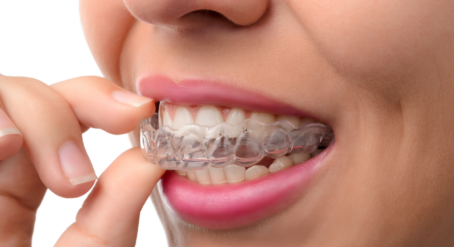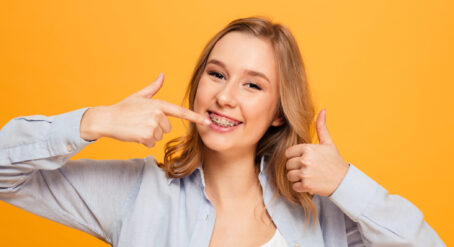Teeth shifting – it’s something we don’t often think about as an orthodontic problem. And while it can take time to notice the difference (think a few months or even years), seeing your teeth misaligned, especially after having orthodontic treatment, can be disheartening.
But how can you tell that your teeth have shifted? And is there anything you can do to prevent them from moving? Read on to discover the answer to these questions and more, so you can maintain your perfectly straight teeth for years to come.
Is it possible for your teeth to shift?
It’s quite normal for your teeth to shift over time – they will move slightly over the course of your life toward the front and centre of your mouth. You won’t, however, necessarily notice the effects of this shift straight away as it’s slow and incremental.
But there are some factors that might affect the degree of movement your teeth undergo, such as gum conditions and other health issues. These factors can then lead to further complications, including crooked teeth and a misaligned jaw.
If you’re concerned about your teeth shifting and want to minimise their movement, it’s best to see an orthodontist for a professional assessment.

Why are your teeth shifting?
Most patients experience teeth shifting in their upper and lower front teeth during their late teens or as young adults. Some of these people had very well aligned teeth before, and it’s easy to blame the wisdom teeth for these changes, as this is the time that they tend to start growing into the mouth. But there are plenty of other factors that can affect the position of teeth.
Your teeth are housed in living and changing bone, rather than set in concrete, so to speak. This means that teeth positions can be affected by any or a combination of:
- late jaw growth which can lead to inward tipping of the front teeth
- changes in the elasticity of the cheeks and lips and/or pressure from the tongue
- loss of gum tissue or bony support for the teeth through gum disease
- forwards drift of the teeth, which can cause the teeth to become crowded.
The common assumption is that the wisdom teeth push and place pressure on the other teeth, which eventually causes the front teeth to become more crowded as we age. Studies have assessed this theory and have found that wisdom teeth are not the primary cause of dental crowding.
In fact, up to 25% of people are missing their wisdom teeth from birth and these patients can still develop the same crowding later in life. Removing wisdom teeth also doesn’t guarantee that the front teeth will stay straight. Due to the common misconceptions around wisdom teeth, these molars are often blamed (unfairly) for dental crowding, even when research states otherwise.
Why is my tooth bite suddenly changing?
While your teeth will gradually shift over time, your bite may suddenly change for a number of reasons, which can include:
- physical trauma, like from an accident
- tooth decay or removal of teeth
- bone disease
- gum disease
If you notice that your bite has changed because of one of these situations, then it’s important you get advice on what to do next from a specialist orthodontist.
Do teeth shift back after braces?
Without correctly using your retainer after your braces treatment, your teeth have a stronger chance of shifting and undoing the work of your orthodontic treatment. Your braces work by applying subtle pressure on your teeth that slowly shifts them into proper alignment, so when your braces are removed there’s always the chance that your teeth will move out of position again. However, the amount of movement is unpredictable and can differ from person to person.
This is why wearing your retainer per your orthodontist’s instructions is important. Regularly wearing your retainer can help keep your perfectly aligned teeth in place after treatment. And if you play any form of contact sport, then we recommend that you wear a mouthguard to protect your straightened teeth.
What if your teeth are straight but your jaw has become misaligned?
No matter how straight your teeth are, sometimes it is the jaws that may be misaligned and this can create bite issues. A misalignment of your jaw can affect your daily life, such as how you eat, talk and even sleep.
While some jaw issues can be attributed to stress or injury, it can also be caused by dental misalignment. Some of the signs of a misaligned jaw you should keep an eye on include:
- shifting of the jaw when closing the mouth
- tightness of the jaw
- pain in your jaw, temple or ears
- difficulty speaking or chewing food
- difficulty closing the lips and/or drooling.
If you experience any of these symptoms, then consult your orthodontist for their advice about possible solutions.

How do you know if your teeth are shifting?
If you’re worried about your teeth shifting, then there are different signs that you can keep an eye on, which include:
- A midline shift is when the line between your two front and lower don’t line up properly and aren’t aligned with the centre of your nose and eyebrows.
- Gum bleeding may be a sign of periodontal problems, which may increase the likelihood of teeth shifting.
- Gaps appearing in your teeth is a common and easy-to-spot sign that your teeth are shifting. Gaps may also be a sign of developing periodontal problems.
- If you experience more tooth pain or sensitivity than usual, this could indicate shifting teeth.
- If your retainer is uncomfortable or ill-fitting, then that’s a sign that your teeth have shifted, as your retainers would have been made to perfectly fit your teeth initially.
Does teeth shifting hurt?
Teeth shifting is an incremental and gradual process, so it generally does not cause pain. However, some causes of shifting teeth may be due to other issues such as developing gum problems. If you ever experience pain from your teeth, you’ll need to book an appointment with your orthodontist to assess the severity and underlying cause.
How can you stop your teeth from shifting?
There are many ways that you can prevent your teeth from shifting after your orthodontic treatment, which include:
- Wearing your retainer correctly is of the utmost importance as it will help keep your perfectly straightened teeth in place.
- Good dental hygiene, such as regular brushing and flossing, will prevent food and bacteria from building up, preventing issues such as gum disease that can cause teeth shifting.
- Regular dental check-ups, as your general dentist will assess the health of your teeth and gums to help prevent teeth shifting due to gum disease before it occurs.
- Don’t grind your teeth, but if this is a problem for you, book an appointment with your general dentist for further assessment.
Tooth movement, like wrinkles or other body changes, occurs with time as a part of the normal aging process. But you can hold off unwanted teeth changes by maintaining good oral health and simply wearing your retainers.
If you’re concerned about your teeth shifting, or other oral health issues, then you can use our Finder Tool to find your local orthodontist and request a consultation.












Hi, I want this treatment but can I know the price so I can decide accordingly
Thank you
Hi Arashdeep, the best way to find out how much any orthodontic treatment is going to cost, is to make an appointment with a local orthodontist. You can use our finder tool to search for an ASO orthodontist near you, and download our ultimate orthodontic quote checklist, to ensure there are no hidden fees. https://orthodonticsaustralia.org.au/all-about-cost/the-ultimate-orthodontic-checklist-download/
Does dental injury cause shifting
Hi Nash,
Yes, a dental injury can cause shifting or it may be the result of natural shift over time. If you’re concerned about the position of your teeth you should consult a specialist orthodontist.